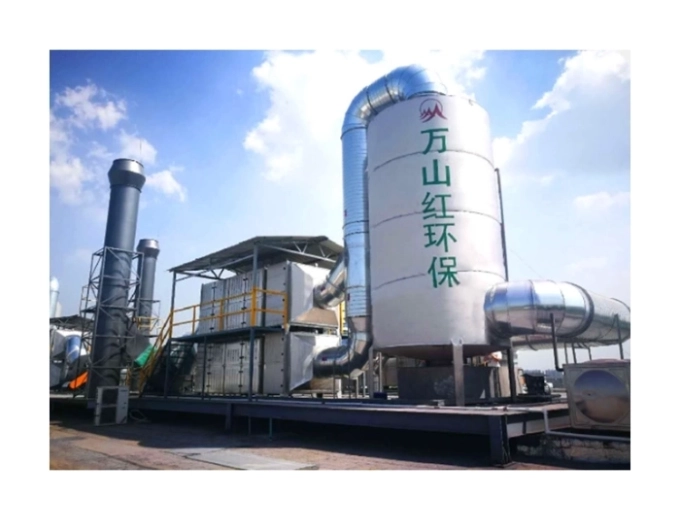Utilizando la innovación tecnológica para apoyar la protección del medio ambiente: conozca las últimas tendencias en equipos de tratamiento de gases residuales de COV
Release time: 2025-10-25
With growing global environmental awareness, effectively reducing harmful gas emissions has become a critical issue for many industries. Volatile organic compounds (VOCs), a major atmospheric pollutant, not only pose serious environmental risks but also impact human health. To address this issue, VOC waste gas treatment equipment has undergone continuous technological innovation in recent years, helping companies manage industrial waste gas more efficiently. This article will explore the latest trends in VOC waste gas treatment equipment and how technological innovation can contribute to environmental protection.
High-efficiency VOC Removal Technologies
Traditional VOC waste gas treatment equipment often relies on technologies such as adsorption and catalytic oxidation. However, with increasing environmental protection requirements, new, high-efficiency technologies are becoming mainstream in the market. For example, low-temperature plasma technology, which has seen rapid development in recent years, uses an electric field to accelerate electron collisions, breaking down VOC molecules and achieving effective removal. Compared to traditional technologies, this new technology not only improves removal efficiency but also operates at lower temperatures, reducing energy consumption and offering significant energy-saving advantages.
Evite conceptos erróneos: Many companies only prioritize technological advancements when purchasing equipment, overlooking the compatibility of the equipment with the actual exhaust gas composition. Therefore, when selecting VOC waste gas treatment equipment, a comprehensive evaluation should be conducted, taking into account factors such as exhaust gas concentration and composition.
Energy conservation and environmental protection become mainstream
With rising energy prices, energy-saving VOC waste gas treatment equipment has become a focus for many companies. Modern waste gas treatment equipment is increasingly focused on energy efficiency. Many devices incorporate intelligent control systems that monitor exhaust gas concentration changes in real time and automatically adjust operating conditions, achieving low-energy treatment results. For example, VOC catalytic combustion equipment uses high-efficiency catalysts to complete the oxidation reaction of harmful gases at lower temperatures, reducing energy consumption.
Evite conceptos erróneos: Many companies believe that energy-saving equipment is more expensive. However, in reality, energy-saving equipment ultimately brings more significant economic benefits to the company by reducing long-term operating costs. Therefore, when selecting equipment, companies should not only consider the initial investment but also the long-term operating costs.
Application of Intelligent and Automated Systems
With the rapid development of the Industrial Internet, intelligent and automated technologies have been widely adopted in VOC waste gas treatment equipment. For example, some advanced equipment equipped with Internet of Things (IoT) technology can monitor exhaust emissions in real time and adjust them through remote control systems. These systems not only improve equipment efficiency but also provide early warning of faults, reducing maintenance costs.
Furthermore, intelligent VOC waste gas treatment equipment can automatically adjust operating parameters based on varying environmental conditions, further enhancing the accuracy and stability of waste gas treatment. The widespread use of such intelligent equipment is a key trend in future environmental technology innovation.
Evite conceptos erróneos: While intelligent equipment is easy to operate, it also requires high technical support and maintenance. When purchasing such equipment, companies should consider whether the supplier provides comprehensive technical training and ongoing support.
Application of Green and Environmentally Friendly Materials
In recent years, the environmental protection industry has increasingly stringent material requirements, and VOC waste gas treatment equipment has begun to utilize more environmentally friendly materials. For example, some new equipment utilizes highly corrosion-resistant green composite materials, which not only extend the equipment’s service life but also further reduce secondary pollution. Furthermore, with the increasing adoption of renewable energy, green energy sources such as solar and wind power are gradually being incorporated into the power supply systems of waste gas treatment equipment, providing strong support for the equipment’s environmental performance.
Evite conceptos erróneos: When selecting equipment, companies often overlook the environmental friendliness of the materials used, leading to increased secondary pollution during subsequent operation. Therefore, when selecting equipment, it is important to pay attention to whether the materials used meet environmental standards.
Regulations and Policies Drive Technological Development
With increasingly stringent environmental regulations, more and more countries and regions have established VOC (Volatile Oxide) emission standards, forcing companies to increase their investment in waste gas treatment technology. To meet these stringent emission standards, VOC waste gas treatment equipment technology is constantly upgrading. This not only promotes technological innovation but also drives the rapid development of the entire environmental protection industry.
Evite conceptos erróneos: Many companies focus solely on the treatment capacity of equipment, but overlook whether it complies with local environmental regulations. When purchasing equipment, ensure that it meets the latest emission standards to avoid penalties for non-compliance.
Resumen
With the continuous advancement of technology, Equipos de tratamiento de gases residuales COV is becoming more efficient, energy-saving, intelligent, and environmentally friendly. When selecting equipment, enterprises should pay attention to multiple aspects such as the equipment’s energy efficiency, intelligent control, and material environmental friendliness to ensure that the equipment can operate stably for a long time and meet environmental protection requirements.



